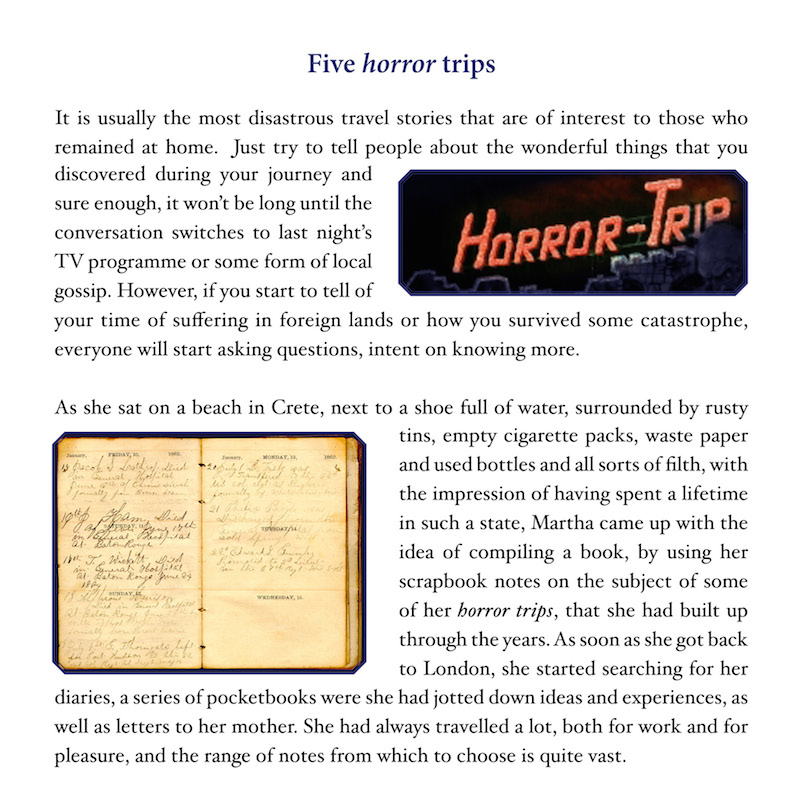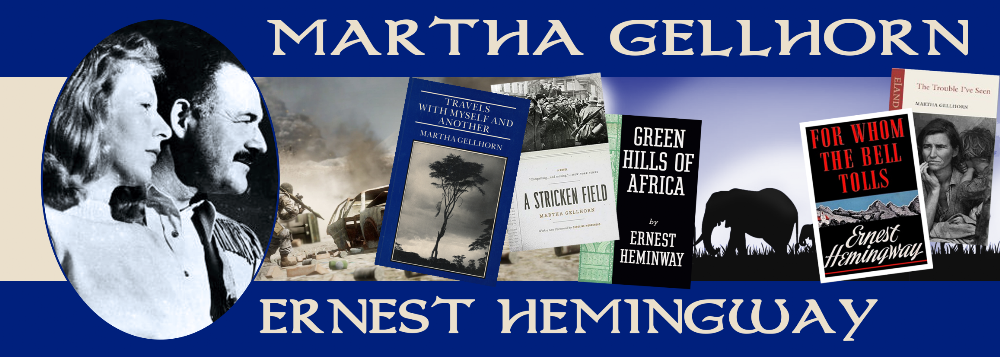
Her most famous journey, unequalled and unsurpassable, was the one to China with her husband Ernest Hemingway, her Unwilling Companion. The director of Collier’s magazine had asked her to go and follow the Sino-Japanese war, and report on the Chinese army in action. It was his opinion that Japan, after having joined the Axis powers, would then start to destroy the East, as Germany was doing in Europe. In Hong Kong, where they had to stay while waiting for permission to have access to the front line, instead of going hunting with her husband in the surrounding hills, she headed into town to look for information on factories, courthouses, opium dens, brothels, dancing and gambling halls, prices and salaries. After a few weeks the permit arrived and Martha and Hemingway left in a plane for Nanyang. The Seventh War Zone that they had to cross was an area as large as Belgium, which had become an expanse of mud, due to the torrential rain falls. In New York, a report on the Chinese army had seemed like a rational project, but on the spot it no longer did. The old Chevrolet they were driving kept getting stuck in the dirt track, which was full of large rocks, and the tyres burst continuously. With each accident, they both held their breath for fear of the consequences. On the river Chiang Jang, awaiting them was a Chriscraft towing a sampan, which they then spent forty-three hours on. They then continue on pony-back: the one Hemingway was riding was so short that he could ride and walk at the same time. Devoured by flies and mosquitoes, they visited the barracks and the fields used for military parades and attended the ceremonies. In a school for cadets they saw portraits of Goering, Mussolini and Chamberlain. They stoically put up with the difficulties and discomfort, although in a hotel in Guilin, where the beds were crawling with bedbugs, Hemingway regretted not having his pistol with him, to shoot at those repulsive creatures. They arrived in Chonqing by plane, the Capital city during the war. Martha described it as “grey, shapeless, muddy... a series of gloomy cement buildings and miserable barracks, humid in the summer, muddy for the rest of the year, dirty, smelly and infested with mice.” The only reason it had been chosen was because it was unreachable.
They had lunch with the Generalissimo and Madam Chiang Kai-shek. In 1937, the two of them had appeared on the cover of Time magazine, as couple of the year. He was thin and stood upright, with a grey uniform, so impeccable that he seemed a statue, and without teeth. When she gave an account of this event to an employee at the American embassy years later, Martha discovered that this was a courtesy reserved only to the most illustrious of guests. They also met Ciu en Lai, the founder of the Chinese Communist Party, who was hiding in town. Chiang’s regime was brutal, corrupt and inefficient. The Generalissimo was only interested in his own power and would in no way heed the miserable conditions of the hoards of slaves which made up most of the Chinese population, in fact, more than the Japanese, who he thought destined to one day vanish “like a rash of pimples”, he feared a communist revolt. These considerations were however made by the journalist years later; the fact of having been a personal guest of the man made it impossible for her to do so at the time.
In January 1962 Martha decided to explore Africa. The account she gives of this journey is the most detailed amongst her works, having been written just after her return to Europe, in a guesthouse in Trieste. Following the advice of her doctor, who had been in Nigeria during the war following the RAF pilots, and who considered the continent to be a horrendous place, a breeding ground for the worst illnesses, she got a vaccination against smallpox, yellow fever, typhus fever, cholera, tetanus and polio and brought medicines for dysentery and malaria, balms for wounds and infections and disinfectants for water. In her suitcase, she took a hot water bottle, a sweater, a pair of wool trousers, a bucket hat, playing cards for playing solitaire, and a pair of binoculars. She departed from Douala, in Cameroon. The landscape was an inhospitable grey-green jungle, punctuated from time to time by muddy rivers following winding routes, and marshy stretches of water full of midges: not exactly at the height of her expectations. Where were the vast golden plains, the blue mountains, the wild animals she had longed to see? The mugginess was so intense that it was like being wrapped in a moist blanket from head to feet. The following day, in Yaoundé, the next stop in the journey, World Leprosy Day was being celebrated. Martha visited a leprosarium where a party was being held and the women danced the twist. Here, Schweitzer was not considered a hero nor a great thinker, his medicine was considered old-fashioned, his life too advertised; there were other less-known doctors who worked with higher standards and in much tougher circumstances. She also went to visit some catholic missions, amongst which that of Père Moll, who told her of his bizarre experiences with Africans. The journey continued into Chad, a name that had always enchanted her since she had been a child. She stopped in Fort Laramy, today known as N’Djamena, before continuing in the direction of Khartoum, where the two branches of the Nile meet. In Kenya the horror trip seemed like it might end; after all, this was the Africa she had always dreamed of. But instead this did not prove to be the case. She had the idea of renting a Land Rover with a driver, so that she could visit the parks, and thus once again a series of dangerous situations reared their ugly heads.
The chapter called One Look at Mother Russia is dedicated to her encounter with Nadežda Jakovlevna Chazina, the author of the book Hope against hope. Nadežda was the widow of the poet Osip Ėmil'evič Mandel'štam, who was born in Warsaw in 1891 and later moved to Petersburg in 1910 and became one of the most well-known figures in the Russian literary environment. Osip was arrested in 1934 for anti-soviet activities and banished. He was betrayed by a friend to whom he had read a poem of his which branded Stalin as an assassin, and in 1938 he was deported to a lager near Vladivostok, where he died. Martha was struck by the courage of this woman, a witness to injustice, who after having supported her husband for nineteen years, then dedicated thirty-four more in order to keep his name alive. Martha wrote to her with great words of praise, and Nadežda replied that she would be extremely happy to meet her in person. In July 1970, Martha left for Moscow, as loaded as a mule, carrying goods that she had been asked for: medicine for ulcers and arthritis, Arpège perfume, nylon socks, a shawl in cashmere, skirts and wool sweaters, jars of marmalade, and records by Menuhin. She did not take any pornographic magazines, which she had also been asked for, but decided to add some bottles of whisky, the detective stories of McBain and Spillane, and the reviews of books which had appeared in the west, provided by the editor. The nightmare began as soon as Martha stepped out of the plane: the heat was suffocating, the airport was so chaotic that she did not know where to go to retrieve her luggage, the currency exchange desks would not change her money and the taxis were not in service: in general, the people seemed to take great satisfaction in answering foreigners with a niet. The hotel was along the road to Minsk, in the middle of the woods... When she finally managed to reach Nadežda’s apartment (she had had it written down on a piece of paper she was ready to swallow in case of danger), she found herself face to face with a small, portly woman, with V-shaped legs, pale blue eyes, who continued to smoke, wheeze and cough incessantly. Her home was invaded by a continuous coming and going of friends and relatives, and as she listened to their conversations, Martha realised that this incongruous manner of speaking, made up of “non sequitur” dialogues where everybody talks and nobody listens, which she had always thought to be an invention of Russian writers, was instead completely real. She found herself tainted by the climate of fear that pervaded this town deprived of books or newspapers, where the radio was constantly disturbed by interference. She had the feeling that she had disappointed Nadežda and her friends: she had not become one of their followers, and she had not joined the chorus of laments of those who seemed to have the monopoly of all the suffering in the world. After one week staying in the Society of Squalor, she had to fight back the desire to kneel down to kiss the carpet of the British Airways plane, which was to take her back to her country. She eagerly read the junk literature that one could buy aboard the splendid British capitalist airline and one thing was certain: never again would she set foot in Russia. However, for the rest of her life she continued to cite Nadežda and stated that, like her, she had tried to report the injustice that she had witnessed, because “it is the duty of writers and journalists to record events, in the hope of unmasking those who do not tell the truth.”
In 1942, struck by the statistics of the war on the sea front - in one year the Germans had sunken as many as 1.508 Allied ships, 71 of them in the Caribbean in two months – Martha proposed to Collier’s that she be sent to the archipelago to gather more detailed information. Her dream was to meet the survivors of a torpedo boat, to discover an undercover enemy radio, to detect some hidden stash put aside for German submarines, or – why not? – sight an enemy submarine itself. She rented a boat, the Pilot, which she used for days on end to move from one island to another, completely in vain and without a single lead. So she decided to stay in Basse-Terre, the capital of the island of St. Kitts, a village so dead that it felt as if she had been buried alive herself. She describes the journey as it happened. The account – 11.000 words instead of the 5.000 requested – is extremely funny, although it leaves the reader without much desire to ever set off again for a foreign destination. She then travelled to Antigua, where there was an Air Force base, and visited the hangars with their rooftops covered in straw, the pilots’ barracks, the headquarters, the covered goods trucks, the wooden bridges and boardwalks. She then travelled to French Guiana and Suriname, where she sent her last article from. Before leaving, she decided to perform one last round of reconnaissance. She rented a boat and headed back up the river Saramcoca – chosen because she liked the name – and arrived at Paramaribo. However the torment of thirst, the itching of insect bites and the lack of room in the tent, put her body and spirit to the test. On the fifth day she felt that she was ready to leave the art of exploration to the explorers, who she decided were completely mad and definitely worthy of veneration for their sheer resistance and stamina. Later, she was in any case glad to have seen those places before the arrival of the dollar had had a chance to turn them upside down, changing the lifestyle and physiognomy, before the hotels, casinos, boutiques, supermarkets, laundrettes, restaurants and snack bars had arrived to take the place of trees and before the row of yachts had sat in the place of what used to be a group of crystal-clear lagoons.
“What makes a journey horrible”, Martha writes in the last chapter, “is boredom.” Of course also being late, getting ill, tiredness, the lack of commodities, and tension all had a part, but mostly to blame for the horror trips, was boredom. Also, one did not have to travel all that far to find it. She mentions that it is enough to observe the participants on a guided tour to the ancient Greek ruins or the Persian mosques, the men with their blank stare and slouching shoulders carrying their bags and those of their wives, the couples who sit in silence in the dining halls of foreign hotels, young parents loaded with toys, nappies and milk bottles, as they walk the streets in search of a B&B to take refuge in. It is also true that horror trips are subjective. A holiday cruise ship, with its organized merrymaking would have been lethal for Martha, whereas many would consider it pleasantly entertaining. Martha had to endure long periods of boredom during her visit to a community of hippies in Israel, with whom she tried to exchange opinions and ideas, without much success. Most of the time, they were under the effect of hashish, and answered vaguely to her questions, often contradicting themselves. They did not have any specific interests, and their conversation revolved around a few places, from Afghanistan to the Far East, where it was easy to stock up on good quality hashish. However, even this frustrating experience is described with irony and a sense of participation. The account she gives, as in the previous ones, rings true and authentic, and the tone, whilst sharp and satirical, is never scornful or derisive. “If instead of hopping around from one place to another with the vigour of a Mexican bean, I had spent a bit more time analyzing my first journeys...” she concludes with some regret, and implies that, had she done so, she would have avoided many unpleasant experiences. We are lucky that she did not, however. This way we can enjoy the brilliant accounts of how her disastrous journeys panned out. 

